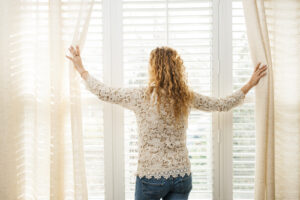Window Treatments Can Be Used to Improve Energy Efficiency
 Windows are attractive features of interior and exterior design, providing an aesthetic connection between the living spaces and the landscape outside the home. Windows may also be a substantial source of heat gain/loss and air leaks, which make HVAC systems work harder to keep your home comfortable. Read on to see how window treatments of several types and styles can treat your comfort and budget right by substantially improving home energy efficiency all year long.
Windows are attractive features of interior and exterior design, providing an aesthetic connection between the living spaces and the landscape outside the home. Windows may also be a substantial source of heat gain/loss and air leaks, which make HVAC systems work harder to keep your home comfortable. Read on to see how window treatments of several types and styles can treat your comfort and budget right by substantially improving home energy efficiency all year long.
Windows and Home Efficiency
During the cooling and heating months, forced-air HVAC systems use energy to heat and cool your home, with the amount directly related to the heat gain/loss through the home’s envelope. The more energy efficient your home’s envelope, the greater comfort and lower energy bills you will enjoy.
Windows are one of the components of the home’s envelope, which also includes doors, walls, floor, the ceiling and insulation. Windows, however, are major contributors to energy losses by heat conduction, solar radiation and air leakage. Window treatments are cost-effective solutions designed to drastically reduce heat conduction and solar heat gain, and boost your home’s energy efficiency.
- Draperies are effective and practical window treatments for blocking heat gain/loss. The right drapes can block one-third of solar heat gain. Factors that dictate the effectiveness of draperies is weave tightness, color and lining. Drape your windows in layers for best visual appeal and, like layered clothing, you may adjust as needed during the day.
- Mesh window screens are effective at diffusing solar radiation, while still allowing light and outside views. Lighter colors are more effective than dark colors for deflecting heat gain, as you would expect. However, with other window treatments in place, choose the color that most appeals to your designer eye.
- Blinds are used to block light as needed. Close-fitting blinds are best for inhibiting heat loss during the cooling months, and deflecting radiation during the cooling months. Look for energy-efficient blinds that are designed with honeycomb or cellular structure. These tiny pockets of air help block heat gain/loss.
- Shades are perhaps the most practical and cost-effective solution for blocking heat gain/loss during the cooling and heating months. Materials vary to allow or restrict light as you prefer. Look for two-sided shades – one light and one dark – that can be reversed for greatest energy savings depending on the season. Make sure the shades fit correctly with as few gaps as possible to trap pockets of air close to the window, which inhibits heat gain/loss.
- High-reflectivity window films are excellent treatments for blocking summertime heat gain on south- and west-facing windows. However, window films also block solar heat gain during the heating months. This is a point to consider before installing these window treatment options.
- Insulated window panels typically consist of rigid foam board, and offer an R4 to R7 insulating factor, which is about the same as Energy Star-qualified high-efficiency windows. Insulated panels push or clip into place, and do not require any hardware.
- Awnings can add pleasant exterior accents to a home, and they provide an exceptional boost to home efficiency by reducing solar heat gain by 65-75 percent on south- and west-facing windows. Awnings are available in a variety of styles, color and materials to suit any exterior design. Automatic and retractable awnings may be drawn back during the heating months to allow solar heat gain. Awnings should have grommets or other openings in the sides and top to allow heat to escape.
- Shutters may be installed to the interior or exterior of windows. Exterior shutters offer possibly the best window insulation. Shutters also offer advantages for security and storm protection, and do not use any interior space.
- Roof overhangs are effective for shading sun-facing windows in the summer and allowing sunlight in during the winter. However, expert installation is required, using passive solar design elements for climate, latitude, illumination levels, solar radiation transmittance, and window size and type.
- Storm panels may reduce winter heat loss through single-paned windows by up to 50 percent. Storm panels are practical upgrades that may be installed on the window’s interior or exterior.
Window Sealing
It’s important to seal air leaks around windows before you begin installing window treatments. Plastic tension strips and foam weatherstripping, for instance, are excellent for plugging leaks around windows (and they are cost-effective). Contact your HVAC contractor for a professional assessment and sealing.
For more window treatment and home energy-efficiency tips, please contact us at Wood Air Conditioning & Plumbing, Inc. We’ve proudly served homeowners of Mount Pleasant and surrounding communities for more than 57 years.
Image Provided by Shutterstock.com
